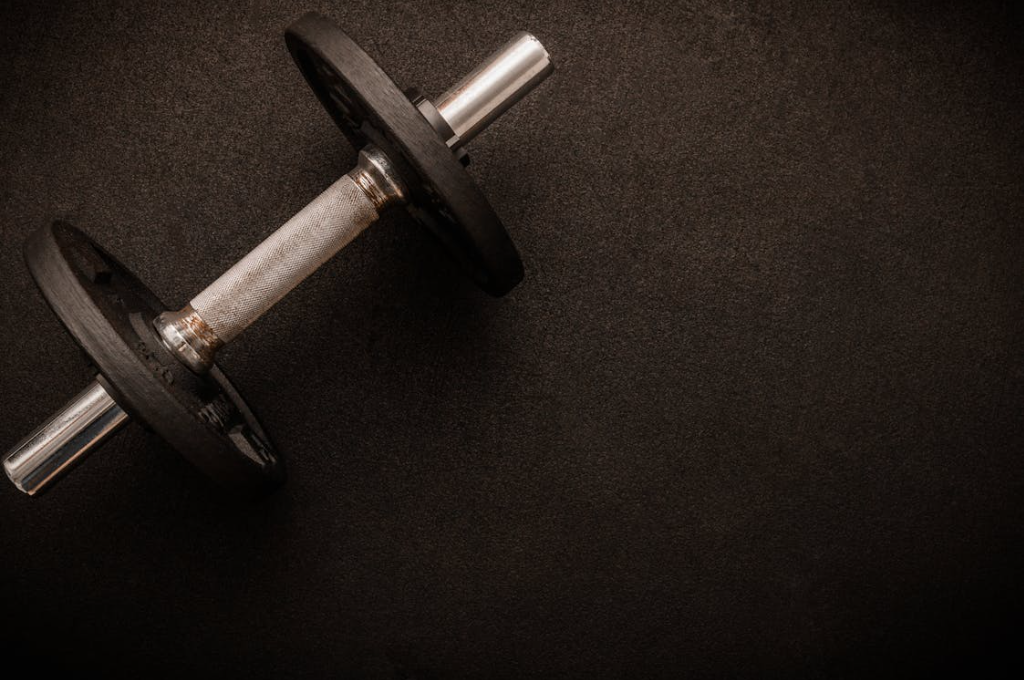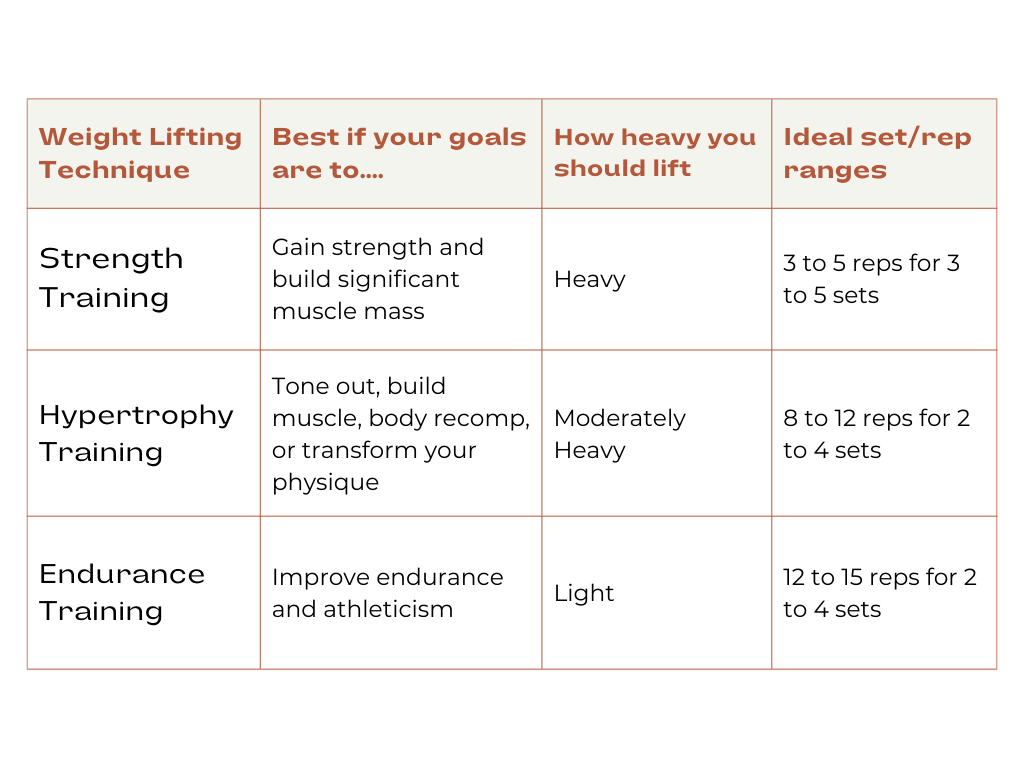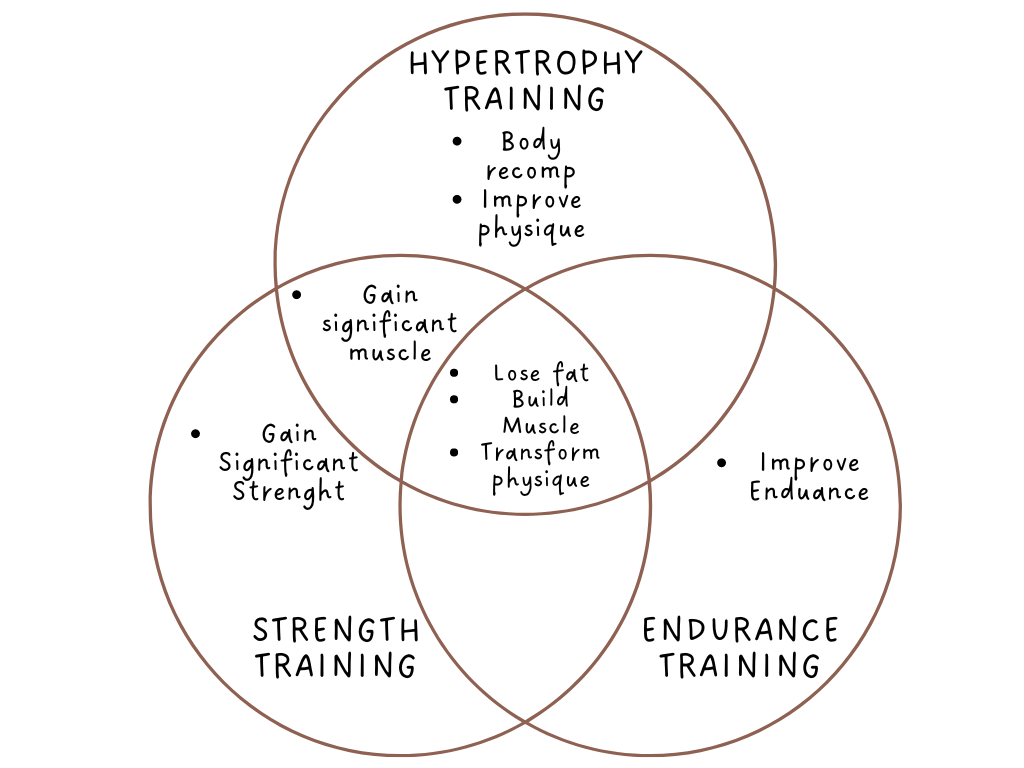
I think almost every single one of us weightlifters has asked ourselves at some point, how many sets and reps should I be doing?
And whether you’re a pro lifter or just starting out, there are a few different things to know to answer that question.
Or really, to determine what the right answer is for you.
So although you might be looking for a universal answer to this question, the truth is, there really isn’t one.
However what there are, are ways to determine what the right answer is for you.
In this post, I want to cover everything you need to know to determine the best sets and reps to achieve your goals as a strength training woman.
What Exactly Are Sets and Reps?
To begin, I want to start off with the basics. What are sets and what are reps?
Well, a rep is one repetition of a single exercise.
For example, if you were to think of an exercise like a bicep curl, this would be one curling motion.
Followed by lowering back down, all the way until you get back into the starting position. That would be one single rep.
A set on the other hand, is more of a group of repetitions of an exercise. One set is composed of usually multiple reps.
With the only exception being a “one rep max”. Which is where you lift so heavy that you can only do one rep of the exercise. Hence the name, one rep max.
A set is followed by a short period of rest before you continue on with another set.
The Different Types of Sets:
To give you a better understanding of sets, there are a few different kinds I’d like to explain.
It’s not essential that you utilize any of these specifically to see progress.
But understanding each one and how they work may help you train more effectively.
The four main types of sets are warm-up sets, top sets, working sets, or deload sets.
Now, to give you more information and more background, I want to briefly explain what each of these means.
These Types of Sets Are:
Warm-up sets:
Warm-up sets are the sets you’ll do at the start of an exercise. These sets aren’t meant to stimulate muscle growth, they’re meant to get you warmed up for the exercise.
As a result, your focus isn’t on lifting heavy. Instead you focus mainly perfecting your form and moving correctly through the motion.
You’d typically only do one maybe two warm-up sets.
Working sets:
Working sets are the sets you’d do after your warm-up sets. These are the sets that are meant to be the most intense and stimulate the most muscle growth.
Because of that, you’d want to be lifting heavy enough weight where you struggle to complete your goal rep ranges.
You’ll typically do anywhere from 2 to 4 working sets of an exercise.
Top sets:
Top sets also come after your warm-up sets and sometimes come after one or two of your working sets.
In fact, some or all, of your working sets may even be your tops sets.
These are the sets when you lift the maximum amount of weight that you’re going to lift for the exercise.
Deload sets:
Deload sets are going to be your sets after you finish your working sets and top sets.
The purpose of these are to unload your muscles after your most intense sets. As well as allow yourself to hit a higher rep range but at a lower weight.
In order to do these, you’d lower the weight back down slightly after your most intense sets.
And typically take the set to failure.
The Best Kinds to Implement into Your Workouts
Like I mentioned earlier, there’s no need to implement any of these specifically into your workouts if you don’t want to add any more confusion.
However, you might find them helpful to your progress.
In my own workouts, I most commonly utilize warm-up sets and working sets.
I find that warm-up sets are a great way to get my muscles ready and engaged for my heaviest sets. And have helped me develop a mind to muscle connection.
How to Choose The Right Set and Rep Ranges in The Gym
Now that I’ve talked so much about these ranges as well as their role in your workout routine, I want to start getting into how you can begin to choose a range for yourself.
More specifically, exactly how you can choose ranges that work for you and your gym goals.

Set and Rep Ranges are Personal
I talked briefly about this earlier, but there really is no one size fits all workout routine that will work for everyone.
This applies to the exercises, sets, reps, style of training, workout types, and so on.
Truth be told, every single one of our bodies is different. We all have different body structures, move differently, and react differently to various styles of exercise.
And there’s nothing wrong with that. But it does mean that your workouts might not look the same as the person’s next to you and theirs might not look the same as yours. And that’s okay!
On top of that, we all have different reasons for working out and goals we want to achieve in the gym.
And since our goals play the biggest role in determining our workout routines, this is just another reason why all of our routines might look a little different.
Set and Rep Ranges are Mainly Determined by Your Goals
That being said, the main factor that is going to determine your ideal set and rep ranges are your goals.
The number of sets and reps you do in the gym aren’t just a number, some thought and intention should go into choosing them.
Because each different range that you may choose serves a different purpose and does different things in your body.
Defining your goals and being very clear what it is you want to achieve from your workouts is the first step to determining this ideal range for yourself.
And just like your goals may change, this range also may change.
That’s why it’s important to be honest with yourself and establish what you want to achieve from your workouts.
Training with Volume vs. Intensity
Before we get into anything else, one major thing you should know is that there are two major ways to weight train.
Applying these methods of training to your workouts isn’t essential for you to see progress.
However, having a simple understanding of the two might be helpful when choosing your goal ranges.
The two major weight training methods I’m talking about here are volume training and intensity training.
Volume Training
Training with volume means that you train specifically based on the amount of work you do.
Which most commonly means the number of sets and reps you do.
To train with volume, you’d most likely train in a high rep range but at a lower weight. Doing more sets of every exercise.
Additionally, you’re goal during a set is to hit a specific rep number, not necessarily to hit failure.
Intensity Training
Training with intensity on the other hand means that you train with the intention of making each exercise intense.
This is commonly achieved using a combination of increasing the number of sets and reps you do as well as increasing the amount of weight you lift.
Additionally, many people who utilize intensity training typically try and train to failure or close to it within a specific rep range.
Doing this is the best way to increase the intensity of your workouts.
Although you don’t need to utilize either of these, both are effective weight training strategies and can play a significant role in muscle growth.
For me personally, I utilize intensity training and try to keep my workouts as intense as I can. By doing this, I’ve found I’ve seen the most muscle growth and progress that way.
Ideal Set and Rep Ranges Based on Your Training Style and Fitness Goals
Now, to determine your goal set and rep ranges, let’s break down each different style of weight training.
Endurance Training:
Endurance training means you’re training to improve your endurance.
With endurance training, you’d be lifting a lighter weight, in a higher set and rep range.
Best If Your Goals Are to: Improve endurance and athleticism.
Strength Training:
Strength training means that you’re training to increase your strength and build significant muscle mass. This is the style of training that most power lifters use.
With strength training, you’d be lifting very heavy weight, in a low rep range but higher set ranger.
Best If Your Goals Are to: Gain significant strength, muscle mass, and power.
Hypertrophy Training:
Hypertrophy training means you’re training to build muscle. This is the style of training that most body builders use.
With hypertrophy training, you’d be lifting decently heavy weight, about 60-80% from your max, in a medium set and rep range.
Best If Your Goals Are to: Gain muscle, body recomp, lose fat, lean out, improve your physique.
A Table Summary of Each Muscle Building Technique:

Additionally, I created a Venn Diagram to compare each of the different lifting techniques and which goals they help you achieve.

The Best Tip to Help You Choose an Ideal Number of Sets
One tip I want to give you when choosing your ideal set range is to experiment.
I gave you some ideal ranges here based on your goals, but determining the best one for yourself depends a lot on you and your body.
It has a lot to do with knowing yourself and knowing what intensity level works for you.
For example for me personally, when I’m going to failure on one of my exercise, sometimes I find that doing less sets works better for me.
I just recently brought a lot of my exercises down from four sets to three sets.
Because by the time I’d get to my fourth set, the muscle I’m targeting would be so fatigued and I wouldn’t have a good mind to muscle connection on my last set.
The Importance of Goal Set and Rep Ranges In Your Weightlifting Routine
At this point, we’ve already covered what sets and reps are and how to choose an ideal range for yourself.
However, I haven’t yet talked about why exactly this is so important yet.
Or rather, what exactly this does for your workouts when you actually have these goal ranges in mind during your training.
The Impact Your Sets and Reps Have on Your Workouts and Your Fitness Results
Gives Your Workouts Structure
The biggest advantage of planning out your set and rep ranges beforehand is that it helps give your workouts structure.
It gives your workouts a well thought out, well-defined guide for your to follow.
When your workouts have this structure, you can train and work towards your goals much more effectively.
Helps You Stay Organized and Train Effectively
On top of that, when you follow a routine and enter the gym with a plan, your workouts become much more organized.
Having organized workouts means you get to the gym with a plan and you don’t need to struggle to think of one on the spot.
Trust me, many of us are all too familiar with how this feeling feels. It can really throw off your workout!
The more time you spend at the gym planning, the less time at the gym you spend working out.
So the less time you spend thinking frantically, the more time you can spend training effectively.
Additionally, if you’re someone who struggles with anxiety in the gym, creating a plan for your workouts is one of the best ways to overcome gym anxiety.
Helps You Push Yourself Harder
Having a plan for the number of sets and reps you’ll do for each exercise can help you train more intensely.
The main reason for that is because these goal rep ranges become like mini goals in your mind for you to achieve throughout your workout.
As you work towards these mini-goals, you continue to push yourself during each exercise. And not just during every exercise, but during every set and rep of each exercise.
For example, when I do an exercise, if I go into it with the goal to do 10 reps, I’ll be much more likely to push myself to hit at least 10 reps.
Whereas if I started the exercise with no goal rep range, then I’d likely just stop the exercise when I felt myself getting tired. Even if I didn’t even actually hit an effective rep range!
Helps You Track your Progress
Paying more attention to your set and rep ranges is a great way to measure and track your progress in the gym.
When you start paying attention to and counting how many reps you consistently hit, you can see your progress right before you.
Overtime, you should find it easier to hit a certain set or rep range at your current weight.
As this happens, you know you’re progressing on your lifts and your workouts are effectively making you stronger.
Allows You to Progressively Overload
Once you get to the point where you’re hitting your rep ranges too easily, now is when you’ll want to progress your workout in some way.
Doing this will continuously increase the intensity of your workouts to allow them to continue to stimulate muscle growth as you continue to make progress.
This strategy is known as progressive overload and works best once you find yourself hitting your old rep ranges too easily.
Some of the best ways to implement progressive overload into your workouts is to increase the amount of weight you lift, the number of sets you do, the number of reps you do, or increase multiple of these.
Overall Helps You Get Closer to Achieving Your Goals
When you start training using specific set and rep ranges, these ranges are going to be based specifically on what your gym goals are.
What this will then mean is that every time you go to the gym, you’ll be training in a way that’s always working you towards your goals.
So every workout you do, you’ll get closer and closer to achieving your goals.
On top of that, most of these other benefits do one of two things: make your workouts more effective or make them easier to follower.
Both of these just happen to be extremely helpful for keeping yourself on track and making sure you’re continuing to progress in the gym.
Takeaways
One of the most common questions among weightlifting women is how many sets and reps they should do.
And rightfully so!
It can feel really confusing trying to determine what the right answer is, especially as a beginner.
However, the key is to determine what the right number is specifically for you, based on you and your own goals.
By establishing your goals, learning about the different weightlifting styles, and knowing you and your body, you can do just that!
Then, before you know it, you’ll have created an effective weight training plan and be on your way to achieving your goals in no time.
More of My Posts on Women’s Fitness and Weightlifting:
The Importance of a Calorie Deficit for Fat Loss
Top Reasons Why Your Strength Training Efforts Aren’t Showing Results